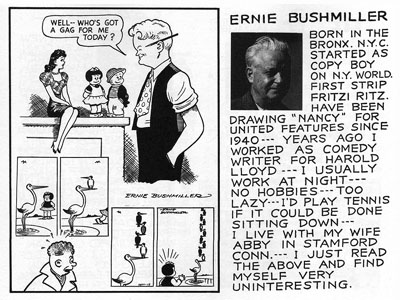
Back in the days of silent comedy, it was not uncommon for cartoonists to write gags for films, or even to get in front of the camera and perform them. The great Harry Langdon once drew cartoons for a living and so did Larry Semon and several others who worked only as gagmen. One of the behind-the-camera gents was Ernie Bushmiller, who wrote for a number of comedians — most notably, Harold Lloyd — before settling down to this life's work. That life's work involved writing and drawing a comic strip that we now know as Nancy.
He did not start the strip; not exactly. In 1922, a cartoonist named Larry Worthington launched Fritzi Ritz, which was about a flapper (i.e., a single, fun-loving lady of the twenties). In 1925, Bushmiller began writing and drawing it and, a few years later, introduced the into the feature, Fritzi's frizzy-haired niece. As Elzie Segar found when his squint-eyed sailor character began crowding all others off the stage of his Thimble Theater, a great supporting player has a way of taking over. Increasingly, the jokes in Fritzi Ritz were about the niece and, by 1938, the quiet takeover was complete. Just as Segar's strip became Popeye, Ms. Ritz's feature was renamed for its new star.
Bushmiller produced his strip until his death in 1982, although the last few years were a morass of recycled or reprinted gags, many of them redrawn by ghosts. Al Plastino drew it for two years imitating Bushmiller, then it was handed off to Mark Lasky and Jerry Scott and from them, to its present proprietors, Guy and Brad Gilchrist. I like the work of the latter two regimes but something is missing…some core simplicity that made Bushmiller's Nancy a favorite, especially of the very young. Elsewhere on this site, Charles Schulz is quoted as saying:
Something amazing happens every time a newspaper tries to drop Nancy. Readers don't just get angry…they get militant. When a paper drops Li'l Abner or Brenda Starr or Dick Tracy, they get a lot of complaints. No matter what the strip is, it's someone's favorite and they complain. But when a paper drops Nancy, they don't get complaints. They get death threats. People get so upset, the paper has to put it back immediately. That strip is such a part of people's lives…their childhoods. For a lot of them, it was the first strip they were ever able to read. It's like your old playground. You may not want to go back to it and swing on the swings or climb on the monkey bars…but you like the idea that it's still there. Everything in this world changes so much it's nice when something doesn't…
I believe that. It was, in a very odd way, a great strip…and it also makes for a great game. My pal, the prolific Scott McCloud, has a great website at — where else? — www.scottmccloud.com. Somewhere in there, and I'll let you find it for yourself 'cause everything there's worth a browse, he has the rules for Five Card Nancy, a card game that uses Nancy panels to build non sequitur (or sometimes even sequitur) continuities. I've played it and it's really quite fun…though once, I played against a fellow who cheated. He had a couple of Sluggos up his sleeve.
If reading Scott's explanation makes you eager to get into a game, Dave White has invented an online solitaire version. You can get to it by clicking right here. It's not as good as playing with actual clipped panels but it's a lot cheaper and less sacrilegious than cutting up old Nancy comic books.